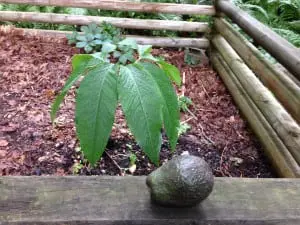Or what shows up in a neglected garden
By Pamela Doan
As I’ve written before, my pregnancy this summer (hello baby Rosabelle!) prevented me from devoting any attention to the garden or landscaping. Now that the baby is here, I’ve started looking around out there again and have discovered a few surprising new plants. Although they’re interesting looking, two have flowers and one has large leaves and a multi-colored stem, I had to turn to my research books to identify them and determine if I had a welcome new addition or an invader. Given all the aggressive, invasive plants that typically crowd out the natives in my yard, my bets were on foe, not friend.

The first guest appeared in the compost pile. Popping up out of the rich mulch is a 2-foot-high plant with long leaves dropping from a black-striped thick stem. Since I get volunteer tomatoes sprouting from seed in the compost pile, my husband’s first guess turned out to be the correct one. He assumed it was something that had been composted, not something that drifted in, and he didn’t recognize it as one of the usual fruits or vegetables we eat like peppers or carrots. Avocado, he guessed.
Avocados grow from trees in warm climates, tropical or sub-tropical. Most kids are familiar with sticking toothpicks in a pit and suspending it in water to get it to sprout, but that’s usually as far as it goes. Keeping the sprout going and turning it into a tree that will bear fruit eventually doesn’t often happen in our climate. I had to turn to the University of California Agriculture and Natural Resources website for information about them. They don’t show up, of course, in any of my resources based on Northeast growing.
Since the avocado isn’t hardy to our climate, I’m going to transplant it to a pot soon and bring it in for the winter. Why look a gift tree in the mouth? If it doesn’t work, I can compost it again, but if it lives, then in 5-13 years (not kidding) I’ll have avocados growing on the patio. Once again, understanding what it takes to grow a favorite food brings new appreciation for it. Patience is necessary.
The original avocado would have been a Hass, but the tree is cross-pollinated and is a hybrid of the original parent and whatever else, not a true Hass. That’s the case with all volunteer plants.
My next discovery turned out to be a foe as I expected. In a patch of yard that I cleared, but didn’t get around to filling in this summer, a 3-foot-high, bushy plant has taken over. At first glance, it has nice pretty flowers. Flowers are good, right? Not in this case. A little investigating confirmed it is Japanese knotweed, a huge problem because it’s aggressive, fast growing, invasive and hard to eradicate. Good times ahead.
Japanese knotweed was intentionally planted as an ornamental plant that turned out to be problematic, as so many of these imported plants become. Outside of their native habitat without their natural checks and balances, many introduced plants go beyond our landscape boundaries.

To get rid of this unwelcome newcomer, I’ll need to resort to using an herbicide, glyphosate, the main ingredient in Roundup. Japanese knotweed spreads through rhizomes and simply cutting it back would trigger new growth. The most effective method is to cut it back to 3 to 4 inches above the ground and then apply Roundup, which at least is a selective herbicide and will affect only the vegetation that it is directly sprayed on. As long as I follow the label’s instructions and take care not to spill it or spray it on surrounding plants, it can be used safely.
Last but not least, I found jewelweed growing in the same area as the Japanese knotweed. The speckled orange trumpet-shaped flowers on dense foliage attract bees and this one is just passing its bloom time. It’s an herb that has been used for many conditions and it is considered a cure for poison ivy. As a native plant, it isn’t a problem. I could treat it like a weed and pull it or I could leave it and let the bees and hummingbirds enjoy it. I quite like the flowers and can’t see any reason to mind it. Welcome to the garden, jewelweed.

